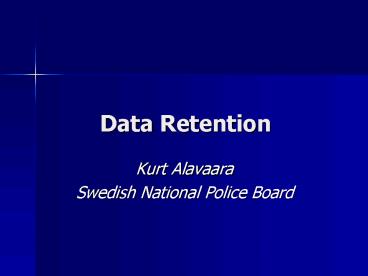Data Retention - PowerPoint PPT Presentation
1 / 10
Title:
Data Retention
Description:
Communications data provides fast, secure and accurate evidence of the ... Law Enforcement agencies, when overlooking the migration from classic circuit ... – PowerPoint PPT presentation
Number of Views:92
Avg rating:3.0/5.0
Title: Data Retention
1
Data Retention
- Kurt Alavaara
- Swedish National Police Board
2
Why is Communications Data needed?
- Communications between criminals are conducted
via electronic communication services. - Communications data provides fast, secure and
accurate evidence of the activities of suspects,
the corroboration of witnesses and victims alike. - Communications data is often the only source of
information which assist Law Enforcement Agencies
to conclude with successful investigations rather
than failure. - Criminals seek to encrypt their communication but
even though content is encrypted, the link
between those persons will still be the
communications data. - The communications data can be seen as
electronic fingerprints.
3
Why is Communications Data needed?
- Communications data is essential for the
- investigation of serious crime.
- The value of such data can not be overstated, it
can be the difference between life and death-
guilt or innocence. - Lack of access to communications data will lead
to more unsolved serious crimes and more cases
where the public authorities could not protect
people from harm.
4
What type of Communications Data is needed in
investigations?
- Where it is necessary and proportionate for legal
purpose is it the data that - assist Law Enforcement to trace and identify the
- (a) source of a communication
- (b) destination of a communication
- (c) date, time and duration of a communication
- (d) type of communication
- (e) users communication equipment or what
purports to be their equipment - (f) location of mobile communication equipment
- The EU DRD does not require the content of the
- communication be retained.
5
EU-Data Retention Directive (EU-DRD)
- The EU-DRD aims to ensure that the communications
data are available for the purpose of the
investigation, detection and prosecution of
serious crime.
6
EU-DRD, developments
- The decision in the EU has resulted in
development of an ETSI-standard for handover
interface for retained communications data. - The Industry has developed technical solutions
for retention of communications data. - Retention solutions must provide security to
address privacy and data protection concerns. - Retained communications data can be stored
encrypted and only accessed in response to a - legal requirement to disclose.
7
Future aspects
- From a Law Enforcement perspective it is
important that development of new techniques and
technologies for electronic communication is
taken into account by the EU-DRD, EU Privacy
Directive and other policy developments. - In the future, there should be industry
standards in place which take account of the data
mentioned in the EU-DRD. - It is of great importance for Law Enforcement
agencies, when overlooking the migration from
classic circuit switched- to packet switched
technology, that the EU-DRD can meet this
migration and safeguard that applicable data is
retained. - To meet the future technologies, such as new
IP-services and Cloud Computing, there is a need
for close co-operation between the public
authorities and the industry. The EU-DRD Group of
Experts has a vital role to play in this context
as an example to member states.
8
Global issues?
- There is an ongoing trend that the data is
processed and stored in the cloud. This new
trend called Cloud Computing is causing new
challenges for Law Enforcement Agencies. - Some of these new challenges can be
- In what jurisdiction is the data kept?
- For how long period is the data stored?
- How is the data secured and protected from
unlawful access if it is stored outside your own
jurisdiction?
9
The Gap?
- The EU-DRD is limited to cover just some of the
electronic communication services, for example
services like chat and FTP is not covered. - As a representative for Law Enforcement Agencies
I am concerned that these services, not covered
by the EU-DRD, are going to be used by criminals
and terrorists to avoid that communications data
is accessible for public authorities.
10
Conclusions
- Communications data is absolutely crucial for the
purpose of investigation, detection and
prosecution of serious crimes and terrorist
threats. - The EU-DRD has been a starting point for
development of technical solutions - for retention of communications data.
- The development of new technical solutions can
also lead to a secure storage, based on
encryption, which can balance the privacy and
data protection concerns. - A close co-operation between public authorities
and the industry is needed - to meet the future challenges.
- The lack of access to communications data from
services which are not covered by the EU-DRD can
be a serious threat against investigation,
detection and prosecution of serious crimes and
terrorist threats. - The efficiency of investigation, detection and
prosecution of serious crimes and terrorist
threats is dependent of the methods and tools Law
Enforcement Agencies can use. The future is not
only a question of privacy it is also a matter of
public safety and security. - The safety and security of the citizens in our
societies is in the hands of the politicians in
the European Union.































